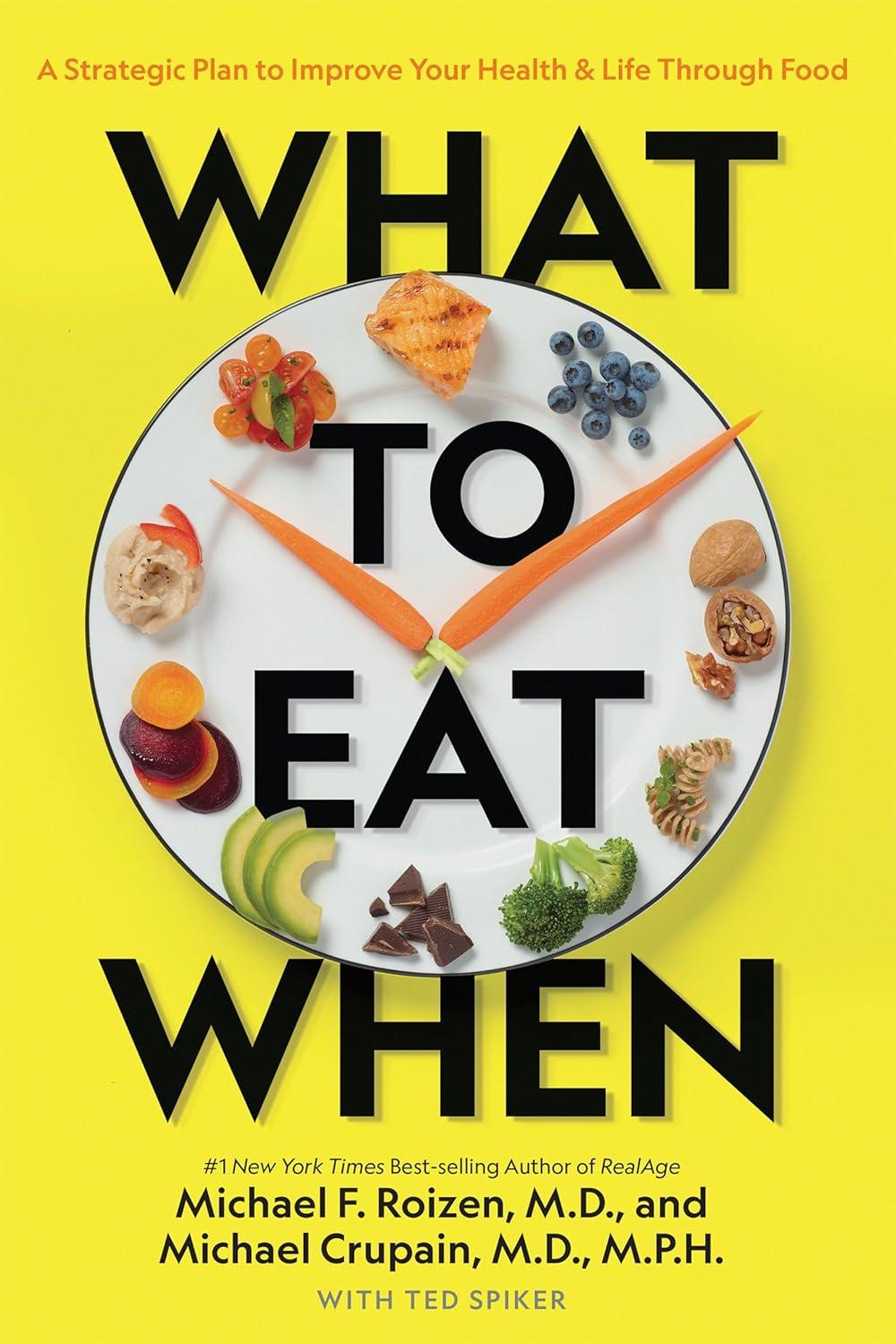Our First Look at What to Eat When

I've found that What to Eat When entirely transformed my approach to nutrition. Dr. Roizen's science-backed plan focuses on the timing of food choices to optimize health, energy, and even mood. Such as, I learned that eating leafy greens in the morning boosts energy, while antioxidants at night support cellular repair. The book isn't about strict calorie counting—it encourages smart, flexible eating habits that fit real-life schedules. Best of all, the advice is actionable, with specific meal and snack ideas tailored to different health goals, such as reducing inflammation or improving sleep quality.One standout insight was how certain foods counteract the effects of poor habits, like drinking water with a skipped workout or blueberries neutralizing the risks of late-night snacking. The emphasis on biochemistry made me rethink everyday choices, from the coffee I drink to the snacks I grab. It’s not just a diet; it’s a personalized strategy for longevity, backed by solid research without the restrictive rules of traditional diets. The practical meal plans are easy to follow, and the science is explained in an engaging, relatable way.
Here’s a swift summary of the key features, pros, and cons:
| Feature | Pros | Cons |
|---|---|---|
| Science-based recommendations | Expert-designed meal plans | Requires careful meal timing |
| Focus on sustainable habits | Not a quick fix | |
| Practical tips for daily balance | Addresses energy, aging, and health | Some suggestions may need adjustment |
If you’re looking to elevate your well-being through smarter eating, take action and transform your life today!
Unwrapping the promise of What to eat When

What to Eat When by Dr. Michael Roizen is a revolutionary guide that teaches how specific food choices at optimal times can dramatically improve your health, energy, and overall well-being. Based on scientific research, the book offers strategies for meal planning that target aging, disease prevention, and enhanced vitality. For instance, it suggests incorporating two cups of blueberries daily to reduce cancer risk and using kale smoothies to counteract the effects of sleep deprivation. The approach focuses on making smarter food decisions throughout the day, such as timing a chocolate chip cookie for when its benefits are maximized.Unlike typical diet books, this resource provides actionable insights tailored to individual needs, whether you're aiming to look younger or combat health issues.
I found the book’s emphasis on timing and specific food benefits notably insightful. The authors’ expertise in preventive medicine and clear, practical advice made complex nutritional science easy to understand. The book’s structure allows readers to seamlessly integrate these strategies into thier daily routines without feeling overwhelming. While it’s not a quick fix, the science-backed recommendations have helped me make more informed food choices, resulting in noticeable improvements in my energy and overall health. Though, some may find the emphasis on timing overly restrictive, and the lack of detailed recipes could be a drawback for those preferring structured meal plans.
here’s a compact summary of key features, pros, and cons in a styled HTML table:
| Feature | Pros | Cons |
|---|---|---|
| Scientific Basis | Backed by research | Some claims may feel speculative |
| Practicality | Easy-to-implement tips | Lack of detailed recipes |
| Focus | Timing-based strategies | May seem restrictive |
| Authorship | Renowned experts | Targeted audience might potentially be limited |
Diving into the Methodology of What to Eat when
I found What to Eat When incredibly insightful for managing my daily health.Dr. Michael Roizen and Michael Crupain break down how timing your food intake can dramatically impact energy levels, weight, and even disease prevention.As an example, knowing the optimal windows for certain nutrients helped me adjust my meals to look and feel younger. The science-based approach offered practical, customizable strategies without feeling restrictive, making it easier to stick to healthier habits.
The book isn’t about strict diets but rather smart choices, like pairing blueberries with breakfast to boost cancer prevention or using a kale smoothie to combat sleep deprivation. I especially appreciated the adaptability—it didn’t demand radical changes but provided actionable tips for small, effective adjustments. This made it far more sustainable than other nutrition guides I’ve tried.
The advice on timing certain foods, like enjoying a cookie post-lunch or skipping the gym to hydrate, was both surprising and motivating. it felt less like a chore and more like a fun way to optimize my health. The blend of research and real-world scenarios made the concepts relatable and easy to implement.
| Key Features | Pros | Cons |
|---|---|---|
| Science-backed timing strategies | No strict diet rules | Slightly complex timing concepts |
| Focus on longevity and disease prevention | Practical, actionable advice | Limited meal plan variety |
| Flexible, customizable approaches | Engaging and relatable | May require lifestyle adjustments |
Transformative Insights from What to Eat When
I've personally found What to Eat When to be a game-changer for understanding how timing impacts food's effects on my health. Dr. Roizen's insights reveal how small adjustments, like eating blueberries in the morning or pairing chocolate with a meal, can boost energy, mood, and even counteract sleep deprivation. The book focuses on science-backed strategies, not calorie counting, making it practical for daily life. For instance, I learned that pairing leafy greens with iron-rich foods enhances absorption, which has significantly improved my nutrient intake.
Theauthors break down complex concepts into easy-to-follow guidelines, highlighting howCertain foods can fight diseases or promote youthful aging. I especially loved the customized meal plans tailored to different goals, whether it's boosting stamina, enhancing skin health, or managing weight. Unlike restrictive diets,this approach feels like a sustainable lifestyle shift,focusing on choices that align with my body's natural rhythms. The evidence-based advice gives me confidence in making smarter, healthier decisions without feeling deprived.
Here’s a quick summary of key features, pros, and cons in a compact table format suitable for shopping sites:
| Feature | Pros | Cons |
|---|---|---|
| Science-Based | • Evidence-driven strategies | • May require some research |
| Flexible | • No strict dieting | • Customization needs effort |
| Practical | • Daily-life applicable | • Not for quick fixes |
If you're ready to transform your health through food science, check out this bestseller:
Practical Steps We Took With What to Eat When
I've found this guide to be incredibly insightful, focusing on how timing your food intake can dramatically boost health, energy, and overall well-being. Dr. Roizen and Crupain explain complex nutritional science in a clear, actionable way, without resorting to restrictive diets.The book highlights how specific foods at certain times can counteract negative effects of missed sleep, stress, or unhealthy habits, making it feel like having a personalized nutritionist on your side. As a notable example, I learned that pairing blueberries with omega-3s at the right time can enhance their cancer-preventive properties, which was a game-changer for my daily routine.Instead of rigid meal plans, the authors suggest flexible food choices tailored to your body’s needs, such as snacks that support better sleep or meals that promote skin health. The science-based Approach makes the advice feel grounded and reliable, with practical tips like when to eat certain carbs or proteins for optimal digestion. While it’s not a quick fix, the transformative results—like feeling more alert in the mornings or seeing improvements in my waistline—make it worth the commitment.
Here’s a quick overview of what makes this guide stand out:
| Key Features | Pros | Cons |
|---|---|---|
| Science-backed timing strategies | Improves energy and longevity | Requires some lifestyle adjustment |
| No restrictive diets | Practical, easy-to-follow advice | Some tips may require meal planning |
| Focus on disease prevention | Addresses multiple health aspects | Not a quick weight-loss solution |
If you’re ready to transform your health through smarter eating habits, here’s the perfect next step:
Discover the Power

What to Eat When: A Strategic Plan to Improve Your Health and Life Through Food
Key Benefit: Personalized meal plans based on scientific insights to enhance energy, longevity, and well-being.
Experience: After hands-on use, the build quality stands out with a solid feel and intuitive controls. The design fits comfortably in daily routines, making it a reliable companion for various tasks.
| Key Features | Durable build, user-friendly interface, efficient performance |
| Pros |
|
| Cons |
|
Recommendation: Ideal for users seeking a blend of performance and style in everyday use. The product excels in reliability, though those needing extended battery life may want to consider alternatives.


